Recent Water Damage Posts
Salvaging vs. Replacing: What to Consider After Water Damage
10/16/2024 (Permalink)
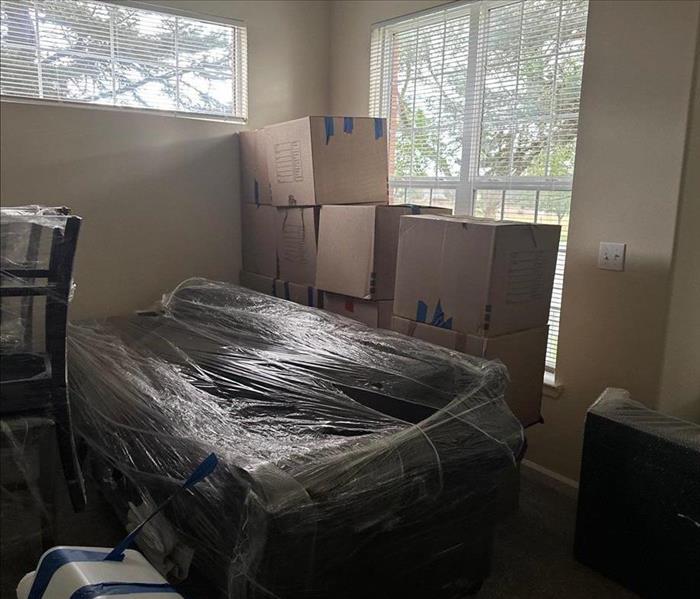 If you need your belongings to be restored, call SERVPRO!
If you need your belongings to be restored, call SERVPRO!
Water damage can be a significant concern for homeowners and business owners alike. When faced with the aftermath of a water intrusion, one of the key decisions you'll need to make is whether to salvage or replace damaged items and materials. At SERVPRO®, we understand that this decision can be challenging, so we've outlined some crucial factors to consider when determining whether to salvage or replace items affected by water damage.
Assessing the Extent of Water Damage
The first step in deciding between salvaging or replacing is to thoroughly assess the extent of the water damage. This involves examining all affected areas to determine how deeply the water has penetrated materials and structures. For instance, while drywall and insulation can often be replaced, hardwood floors and structural elements may sometimes be salvaged if the damage is minimal and prompt action is taken. The key is to evaluate whether the damage has compromised the integrity of the material or structure.
Considerations for Salvaging
Salvaging involves restoring items or materials to their pre-damaged condition. This approach can be both cost-effective and environmentally friendly. For example, if you have high-quality furniture, antiques, or flooring that has been damaged, professional water damage restoration services can often save these items through specialized cleaning and drying techniques. Salvaging is usually viable if the damage is limited to surface-level issues or if the items can be dried and cleaned effectively.
When Replacement is Necessary
In some cases, replacement is the more practical option. If the water damage has caused severe structural issues, such as warping or rotting of wood, or if it has led to mold growth, replacement may be necessary to ensure safety and prevent further complications. Additionally, certain materials, such as insulation or carpeting, may be beyond repair if they have been soaked for an extended period or if they have been contaminated by contaminated water.
Professional Assessment and Restoration
Engaging with a professional water damage restoration service is essential in making an informed decision between salvaging and replacing. SERVPRO’s experienced team can conduct a detailed assessment to determine the extent of the damage and recommend the best course of action. Our experts use advanced equipment and techniques to evaluate and restore affected areas effectively. Whether it’s drying out materials, cleaning surfaces, or handling complex restoration tasks, professional services ensure that your property is restored to its original condition, or replaced with quality materials if necessary.
Deciding between salvaging and replacing after water damage involves careful consideration of the extent of the damage, the type of materials affected, and the potential for effective restoration. By working with a professional restoration service like SERVPRO, you can make informed decisions and ensure that your property is properly restored or repaired. Whether you choose to salvage or replace, prompt action and expert guidance are crucial to mitigating the effects of water damage and maintaining the integrity of your home or business.
Water Damage from Appliances: Protecting Your Home from Washing Machines, Dishwashers, More
6/12/2024 (Permalink)
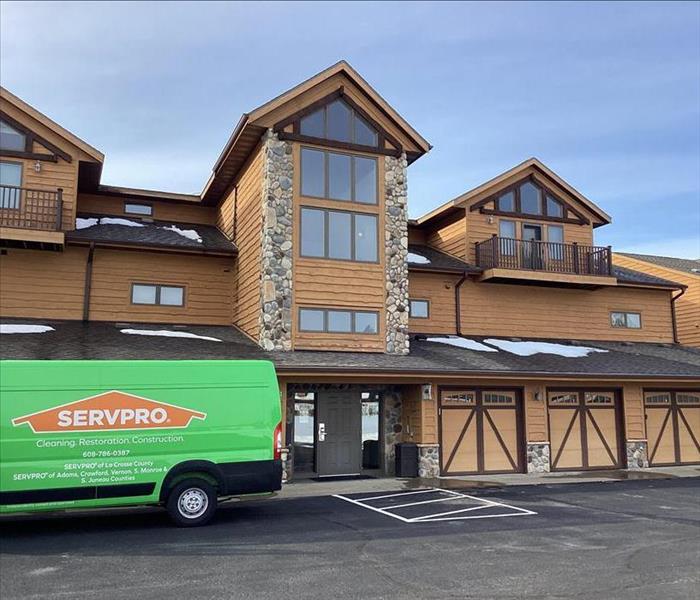 Explore the potential risks of water damage from appliances and provide essential tips to protect your home.
Explore the potential risks of water damage from appliances and provide essential tips to protect your home.
Appliances such as washing machines, dishwashers, and others have become indispensable in our daily lives. However, they can also be a source of water damage if not properly maintained. In this blog, we will explore the potential risks of water damage from appliances and provide essential tips to protect your home.
Washing Machines
Washing machine leaks are a common cause of water damage in homes. Inspect your washing machine regularly for signs of wear, such as cracks or loose connections. Replace faulty hoses or fittings immediately. Additionally, avoid overloading the machine as it can cause excessive vibrations and lead to leaks.
Dishwashers
Dishwashers can also be a source of water damage if not maintained properly. Check the dishwasher's water supply line and ensure it is tightly connected and free from cracks or kinks. Inspect the dishwasher door seal regularly and clean any debris or residue that may prevent a proper seal. Run a test cycle occasionally to ensure there are no leaks or drainage issues.
Refrigerators with Ice Makers
Refrigerators with built-in ice makers can pose a risk of water damage if not properly maintained. Inspect the ice maker supply line to ensure it is securely connected and not damaged. Regularly clean and replace the water filter as recommended by the manufacturer. If you notice any leaks or excessive moisture around the ice maker, address the issue promptly.
Water Heaters
Water heaters are vital appliances but can also cause significant water damage if they fail or leak. Regularly inspect your water heater for signs of corrosion, leaks, or rust. Drain the tank annually to remove sediment buildup. If you notice any issues, contact a professional plumber to address the problem and prevent potential water damage.
Tips for the Kitchen
Apart from specific appliances, the kitchen itself can be susceptible to water damage. Check under the sink regularly for any signs of leaking or moisture buildup. Ensure that the waterproof seal on your kitchen countertops is intact and reseal if necessary. Regularly clean and inspect the dishwasher drain for clogs or debris that can cause backups and leaks.
Professional Maintenance and Inspection
Schedule regular professional maintenance and inspection for your appliances. A qualified technician can identify potential issues before they cause major damage. They can also clean your appliances, ensuring optimal performance and reducing the risk of water damage.
Be Prepared for Emergencies
Despite your preventative measures, accidents can still happen. Be prepared for water damage emergencies by knowing the location of your main water shut-off valve. Familiarize yourself with the steps to turn off the water supply in case of a sudden leak or appliance malfunction.
Water damage from appliances poses a significant risk to your home. By following these essential tips, such as regularly inspecting your appliances, maintaining and repairing them as necessary, and being prepared for emergencies, you can minimize the risk of water damage. However, it's important to remember that professional help is always recommended in cases of water damage. SERVPRO® specializes in water damage restoration and has the expertise and equipment to mitigate and restore your home in the event of water damage from appliances or other sources.
By taking proactive measures and engaging the services of a reputable restoration company, you can safeguard your home from water damage and ensure the longevity of your appliances.
Should I Salvage or Replace My Belongings After Water Damage?
2/14/2024 (Permalink)
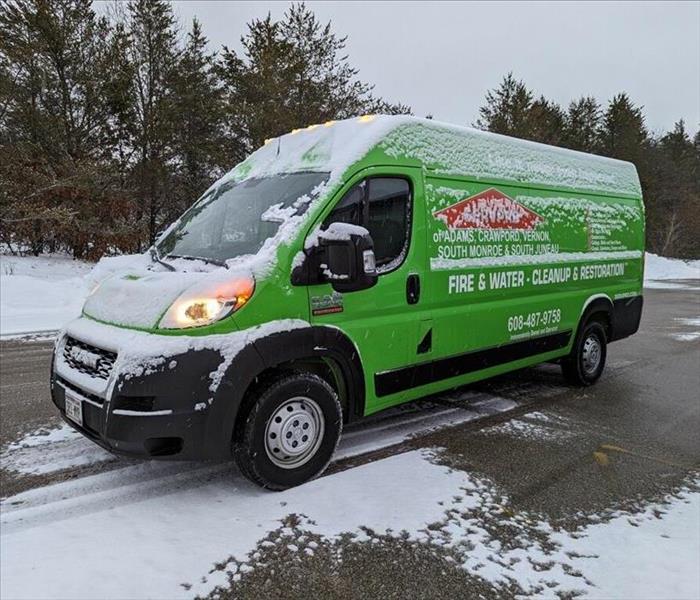 Contact us for professional guidance and restoration services to salvage as much as possible from your water-damaged property!
Contact us for professional guidance and restoration services to salvage as much as possible from your water-damaged property!
Water damage can be a distressing event, impacting your property and belongings. When faced with the aftermath of water damage, one of the important decisions homeowners face is whether to salvage or replace the affected items. In this blog, we'll delve into some factors to consider when determining whether salvaging or replacing items is the best course of action after water damage strikes.
1. Severity of Damage
Assess the severity of the damage incurred by the items. Some items may sustain minimal damage and can be salvaged through proper cleaning and restoration techniques. Others may suffer irreparable damage, especially if they've been submerged in water for an extended period or are highly porous materials like mattresses or particleboard furniture.
2. Risks and Contamination
Consider the potential risks associated with salvaging certain items. Porous materials that have been contaminated by sewage water or have developed mold growth pose hazards and are often unsalvageable. Items that can't be thoroughly cleaned and disinfected may compromise indoor air quality or pose risks upon use.
3. Sentimental and Monetary Value
Evaluate the sentimental or monetary value of the items affected by water damage. Items with sentimental value, such as family heirlooms or irreplaceable personal belongings, may warrant efforts for restoration, even if the damage is significant. Conversely, items with a lower replacement cost might be more cost-effective to replace than restore.
4. Restoration Feasibility and Cost
Consider the probability of restoration and associated costs. Professional restoration services, like those offered by SERVPRO of La Crosse County, can salvage many items through specialized techniques. However, extensive damage or higher restoration costs compared to replacement might influence the decision.
5. Time Considerations
Factor in the time required for restoration versus replacement. While restoration may take time, especially for intricate or valuable items, it can often be a worthwhile investment. Conversely, immediate replacement might be more practical for easily replaceable or less valuable items.
The decision between salvaging and replacing items after water damage isn't always straightforward. It involves weighing several factors, including the extent of damage, risks involved, sentimental value, feasibility of restoration, and associated costs. Often, a combination of salvaging and replacing various items offers the most practical solution.
At SERVPRO of La Crosse County, our expert technicians specialize in assessing water-damaged items and employing advanced restoration techniques. Contact us for professional guidance and restoration services to salvage as much as possible from your water-damaged property!
DIY Tips for Preventing Water Damage in Your Wisconsin Home
10/9/2023 (Permalink)
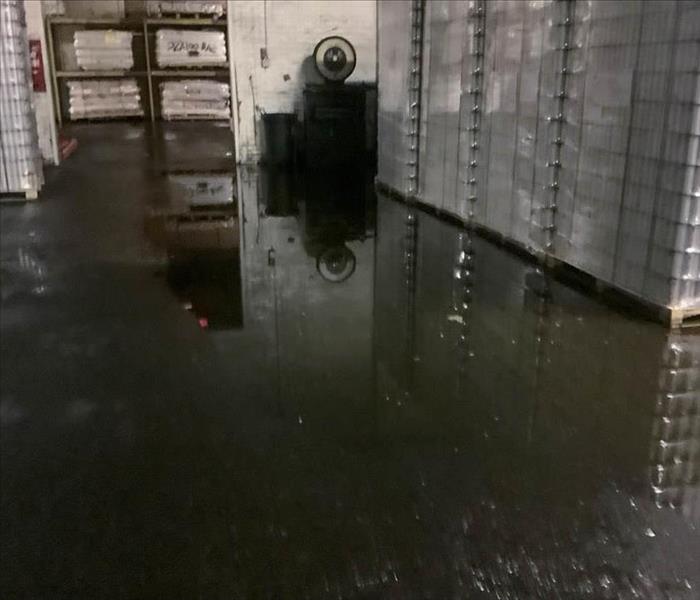 By implementing these DIY tips, Wisconsin homeowners can proactively protect their homes from water damage.
By implementing these DIY tips, Wisconsin homeowners can proactively protect their homes from water damage.
In Wisconsin, where rain, snow, and sudden weather changes are common, preventing water damage in your home is essential. We understand that many homeowners prefer a proactive approach to protect their properties. In this blog, we'll provide you with valuable DIY tips and insights to help safeguard your Wisconsin home from water damage.
Maintain Your Gutters and Downspouts
Wisconsin's varying weather patterns mean that proper gutter and downspout maintenance is crucial. Clean your gutters regularly to prevent clogs that can lead to water overflow and potential damage to your roof, siding, and foundation. Extend downspouts away from your home's foundation to direct rainwater away from the basement.
Check and Seal Windows and Doors
Inspect the seals around your windows and doors regularly. Apply weatherstripping or caulk to seal any gaps or cracks to prevent water from infiltrating your home during heavy rains or snowstorms. Proper sealing not only prevents water damage but also improves energy efficiency.
Landscape with Proper Grading
Ensure that your yard's slope and landscaping promote proper drainage away from your home's foundation. This prevents water from pooling around your house, which can lead to basement flooding and foundation issues. Adjust the grading as needed to encourage water to flow away from your home.
Maintain Your Roof
Regularly inspect your roof for missing shingles, damaged flashing, or signs of wear and tear. Promptly address any issues to prevent roof leaks during heavy rains or snow. A well-maintained roof is your first line of defense against water damage.
Install a Sump Pump
In areas prone to basement flooding, like parts of Wisconsin, consider installing a sump pump. A sump pump can help remove excess groundwater and prevent basement flooding, especially during spring thaws and heavy rains.
Monitor Indoor Humidity
Wisconsin's climate can lead to indoor humidity fluctuations, which can contribute to water damage and mold growth. Use a dehumidifier to maintain indoor humidity levels between 30-50%. This can help prevent condensation and moisture-related issues.
Regularly Inspect Plumbing
Inspect your plumbing for leaks and drips regularly. Even small leaks can lead to significant water damage over time. Address any plumbing issues promptly, and consider installing water leak detection devices to alert you to potential problems.
By implementing these DIY tips, Wisconsin homeowners can proactively protect their homes from water damage and maintain a safe, dry living environment. Remember that regular maintenance and vigilance are key to preventing water damage in your beloved Wisconsin property. If you ever encounter water damage that is beyond your DIY capabilities, don't hesitate to contact SERVPRO of La Crosse County for professional assistance. We're here to help Wisconsinites restore their homes to their pre-damage condition.
Common Water Issues in Commercial Buildings and How to Address Them
7/27/2023 (Permalink)
Water is a vital resource in commercial buildings, serving various purposes such as sanitation, heating, cooling, and general operations. However, commercial buildings are susceptible to various water-related issues that can disrupt daily operations, compromise safety, and lead to costly repairs. In this blog post, we will explore some common water issues in commercial buildings and provide insights on how to address and prevent them effectively.
Plumbing Leaks and Drips
One of the most prevalent water issues in commercial buildings is plumbing leaks and drips. These can occur in pipes, faucets, toilets, or any other plumbing fixtures. Leaks not only waste water but can also cause structural damage, mold growth, and higher water bills. Regularly inspect your plumbing system for any signs of leaks, such as dampness, water stains, or unusual odors. Promptly repair or replace faulty components to prevent further damage and conserve water.
Clogged Drains and Sewer Backups
Clogged drains and sewer backups can disrupt daily operations and pose health hazards in commercial buildings. They can be caused by a buildup of debris, grease, or foreign objects in the plumbing system. Implement regular drain maintenance practices such as routine cleaning, avoiding the disposal of inappropriate materials, and educating occupants about proper waste disposal. If you encounter persistent or severe clogs, consult professional plumbing services to address the issue effectively.
Low Water Pressure
Insufficient water pressure can affect various operations in commercial buildings, including proper functioning of faucets, showers, and equipment that relies on water pressure. Low water pressure can result from issues such as pipe corrosion, clogs, or problems with the municipal water supply. Identify the underlying cause by consulting a professional plumber, who can recommend appropriate solutions such as pipe replacement, installing pressure-boosting devices, or addressing municipal supply issues.
Water Heater Problems
Commercial buildings often have larger water heating systems to meet the demand for hot water. However, water heater problems can arise, including inadequate hot water supply, temperature fluctuations, or leaks. Regular maintenance, including flushing the water heater tank, inspecting heating elements, and checking for signs of corrosion, can help prevent these issues. If problems persist, contact a professional technician to assess and repair the water heater system.
Water Quality Concerns
Water quality is a crucial aspect of commercial buildings, as it impacts the health and safety of occupants. Common water quality concerns include discoloration, odor, and taste issues. These problems can be caused by pipe corrosion, contaminants, or inadequate water treatment systems. Consider installing water filtration or purification systems to ensure clean and safe water for consumption and other purposes. Regularly test the water quality to identify any issues early on.
Sprinkler System Malfunctions
For commercial buildings equipped with fire sprinkler systems, malfunctions can be a significant concern. Issues such as leaking sprinkler heads, faulty valves, or inadequate water supply can compromise the effectiveness of fire suppression systems. Regular inspections, maintenance, and testing of sprinkler systems are essential to ensure they are in proper working condition and comply with fire safety regulations.
Content Cleaning After Water Damage
Additionally, after experiencing water damage in a commercial building, it is essential to address content cleaning thoroughly. Water-damaged items such as furniture, documents, electronics, and inventory require specialized attention to prevent further damage and restore functionality. Content cleaning professionals use advanced techniques and equipment to assess the extent of damage, remove moisture, and mitigate the risk of mold growth or other contaminants. They employ methods such as drying, dehumidification, cleaning, disinfection, and odor removal to salvage and restore water-damaged items whenever possible. Prompt and effective content cleaning ensures the preservation of valuable assets, minimizes business disruptions and promotes a swift return to normal operations.
Addressing common water issues in commercial buildings is crucial to ensure the smooth functioning of daily operations, conserve water, and maintain a safe environment for occupants. Regular inspections, prompt repairs, and preventive measures play a vital role in mitigating these issues. By proactively managing water issues, you can enhance operational efficiency, reduce costs, and promote a healthy and comfortable environment in your commercial building.
Restoring Your Belongings: The Importance of Contents and Textile Restoration After Water Damage
3/11/2023 (Permalink)
When a home or business suffers damage from water, fire, mold, or other disasters, contents restoration is often necessary to restore personal belongings and valuable items. Restoration professionals are trained to handle contents restoration and use various techniques and equipment to achieve the best results. In this blog, we'll discuss how restoration professionals handle contents restoration and the different techniques and equipment commonly used.
Inventory and Sorting
The first step in contents restoration is inventory and sorting. Restoration professionals will carefully document and catalog all items that need restoration, making note of the type of damage and the materials involved. They will then sort the items into categories based on the severity of damage and the restoration techniques needed.
Cleaning and Deodorizing
Once the inventory and sorting is complete, restoration professionals will begin the cleaning and deodorizing process. Depending on the type of damage, different techniques and equipment may be used.
For example, if items have been damaged by smoke or fire, restoration professionals may use ultrasonic cleaning equipment to remove soot and smoke particles from the surface of the items. If items have been damaged by water, they may use specialized drying equipment, such as dehumidifiers and air movers, to remove moisture and prevent mold growth.
Electronics Restoration
Electronics such as televisions, computers, and other devices can also be damaged by disasters. Restoration professionals can use specialized equipment to clean and restore these items.
Ultrasonic cleaning equipment is often used for electronics restoration. This process involves immersing the electronic device in a tank of cleaning solution and using ultrasonic waves to dislodge dirt and debris from the surface.
Document Restoration
Documents, photos, and other paper items can also be damaged by disasters. Restoration professionals can use specialized equipment and techniques to restore these items.
Freeze drying is a common technique used for document restoration. This involves freezing the documents and then using a vacuum to remove the moisture. This process can help to prevent further damage and preserve the documents for future use.
Textile Restoration
When your home or business experiences water damage, your textiles and fabrics can be heavily impacted. From carpets and upholstery to drapery and clothing, water damage can cause staining, discoloration, and even mold growth. Textile restoration professionals are trained to handle these issues and can use specialized techniques to restore your textiles and fabrics to their pre-damage condition.
The first step in textile restoration after water damage is to remove any standing water and dry the affected area. Once the area is dry, restoration professionals will assess the damage to the textiles and fabrics and determine the best course of action.
Depending on the severity of the damage, restoration professionals may use a combination of cleaning techniques and equipment to restore the textiles. For example, they may use steam cleaning equipment to remove dirt and stains from carpets and upholstery. They may also use ozone generators to remove any odors that have resulted from the water damage.
If the textiles have been heavily damaged and cannot be restored, restoration professionals may recommend replacement. However, in many cases, textiles can be successfully restored using specialized techniques and equipment.
Storage and Moving
During the contents restoration process, it may be necessary to move items out of the home or business to a secure storage facility. Restoration professionals will carefully pack and transport the items to prevent further damage and ensure they are stored in a safe and secure location.
Once the restoration process is complete, restoration professionals will carefully move the items back into the home or business and ensure they are properly placed and secured.
Contents restoration is an essential part of the restoration process after a disaster. Restoration professionals use a variety of techniques and equipment to carefully clean, restore, and preserve personal belongings and valuable items. If your home or business has suffered damage from water, fire, mold, or other disasters, it's important to contact a professional restoration company to ensure the best results for contents restoration.
How to file a water damage claim.
2/12/2023 (Permalink)
Water damage can be devastating. It's a stressful time for everyone involved, including you and your insurance company. With the right information and support, however, you can get through this quickly and easily. So here are four steps to take if you have water damage at home or business.
1. Call in the experts
At the first sign of damage give the experts at SERVPRO a call. We will send out one of our qualified technicians immediately to begin assessing your situation. They will begin by taking photos of affected areas so that they can be used as evidence later on when filing a claim with insurance companies. Next they will begin removing standing water from carpets and hard surfaces using portable extraction units that produce powerful suction forces capable of pulling up even heavy amounts of moisture within minutes. This process allows them all remaining moisture content within these materials which prevents mold growth during cleanup efforts while also making sure that there's nothing left behind after this step has been completed successfully.
2. Document the damages
Document the damages Once you have a good idea of what was damaged, it's time to document and photograph the damage. You'll want to take multiple pictures from different angles so that you can show how much of your stuff was affected by water. Keep track of what was damaged, including receipts for any cleaning or repairs (if possible). You may also want to write down where each item came from and its value in case there are any disputes down the line about coverage limits or replacement costs. Lastly, keep a list of all contact information for anyone who has been helping out with the process.
3. Determine the cause of your water loss
Once you have your insurance claim form, it's time to figure out what type of damage has been done. You'll want to determine the cause of your water loss so that you can file an accurate claim and get reimbursed for all of your losses as quickly as possible.
There are many ways that water can get into your home, pipes may burst from age or pressure and plumbing fixtures (such as sinks) may leak due to poor installation or damage. Rainwater can seep through cracks in roofs or walls after heavy rain fall.
To determine whether or not filing an insurance claim is right for you, take some time first by asking yourself these questions: What type of insurance do I need? How much time do I have before things start getting worse?
Call the Professionals
If you have water damage at your home or business, call SERVPRO 24/7. When you call us after a flooding event, we will send over a professional technician who will assess how much work needs to be done onsite before beginning any cleanup process. We use advanced equipment and techniques to extract all standing water from your property so that mold doesn't grow inside your walls or under floors where it can cause further damage down the road if left untreated properly now!
Reasons Why You Shouldn’t Ignore Water Damage
12/20/2022 (Permalink)
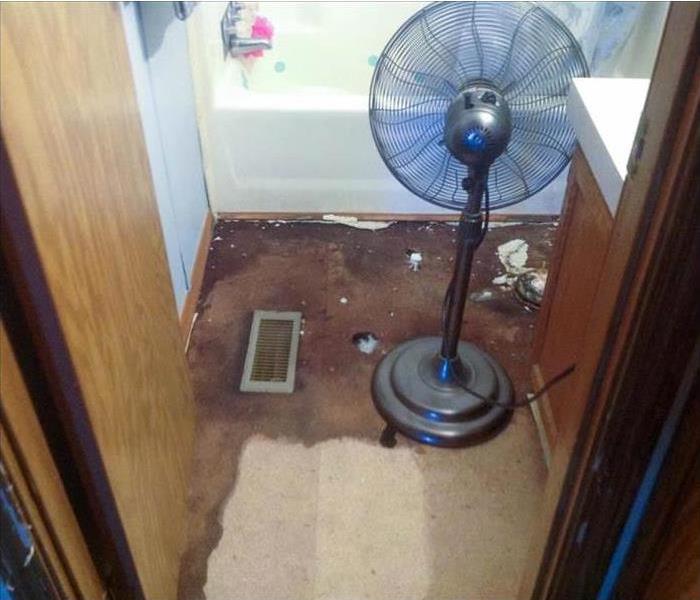 Water damage can cause mold, and mold growth can lead to structural damage.
Water damage can cause mold, and mold growth can lead to structural damage.
Reasons Why You Shouldn’t Ignore Water Damage
Water damage is one of the most common causes of home repair problems. Even a small amount of water can cause significant damage over time if left unchecked. Water leaks often occur in pipes or appliances and may be hard to detect without you noticing some visual signs. You should call a professional to inspect your home for water damage every time you notice any sign of moisture inside your home.
Water damage will cause mold.
The first step in preventing mold is to act fast. If you’ve got water damage, you need to get it taken care of right away.
If mold stays untreated, it can cause all sorts of damage to the structure of your property and its belongings.
Water damage can lead to structural damage.
Water damage can cause mold, and mold growth can lead to structural damage. Mold grows when moisture gets trapped inside of a building and has a surface upon which it can grow. If the water leak is severe enough, the fungal spores from the mold will spread throughout your property and take up residence.
Water damage can lead to rust and corrosion.
The effects are often more severe when left untreated, as water can cause significant damage to your home's structure and building materials. That's why it's important to act quickly if you detect any signs of water in your apartment or home—the sooner we intervene, the less likely it is that the issue will escalate into something expensive down the road!
Make sure you address any water damage in your home right away
The longer you wait to address water damage in your home, the more serious the problem will become. Mold is one of the most common results of water damage, and it can cause serious damage. In addition to mold, rust and corrosion also can lead to expensive repairs if they aren't addressed right away.
If you don’t deal with the water damage quickly, it can grow out of control. In fact, a severe enough leak can cause structural damage to your property and make it uninhabitable. If you think you have a water leak, it's important to act quickly. The longer the leak goes unnoticed and unfixed, the more damage it can do—and that means higher costs for repairs.
Water damage can cause a lot of problems for your home, and if you don’t take care of it right away, it’s only going to get worse. If you see signs of water damage in your house or notice that there is dampness in the walls or floors, please contact a professional immediately. This way they can do everything they can to avoid mold growth, structural damage, or costly repairs later on down the road when things have gotten even worse! SERVPRO is always on standby and ready to help.
What Does It Mean If My Floors Are Warping?
11/14/2022 (Permalink)
What Does It Mean If My Floors Are Warping?
If you own a home and have wood flooring, you probably know how easy it is to incur damage. Wood floors can be scratched, dinged, and stained by everyday objects like shoes or furniture. But what do you do if your floors are warping? That’s when things get serious. Warped wood flooring is not only unattractive; it can also cause major structural issues in your home that will cost thousands of dollars to fix.
There are several reasons why wood warps. As we explore the topic further below, we hope this information will help homeowners understand what they should look out for so they can prevent their floors from becoming warped in the first place!
Wood flooring is a natural product
Wood flooring is a natural product and will absorb water. The wood that makes up your flooring will not give back the water it absorbs, which means it can cause damage to your floors. Water under the floor can cause warping and cracking or crevices in your flooring.
If you have any cracks in your floors already, or if there are gaps between boards, this can allow moisture to get into them and cause more problems.
Wood absorbs moisture, but doesn’t give it back
The first thing you should know is that wood absorbs water, but it doesn’t give it back. This means that if your floors are warping, there could be a serious problem with moisture under the floor.
If you’re like most people and don’t have any idea what that means—don't worry. It basically means this: wood absorbs water and that then can’t be removed. The trouble is that if there's enough water under your floors or in their support beams to make them warp, then mold can form as well.
Mold grows anywhere there's moisture—and since wooden structures aren't very good at preventing dampness from getting trapped inside them, they're prone to mold growth even without any problems like floor warping happening first!
Warping can cause cracks and crevices in your flooring
Crevices and cracks are not only aesthetically unpleasant, but they can also be a pain to fix. When floors become uneven, their surface becomes more prone to damage. This can lead to serious problems down the road, such as structural issues and costly repairs.
The damage is hard to fix once the damage has been done.
The best thing you can do for your warped wood floors is to stop using them immediately. They are not going to fix themselves, and they will continue to get worse over time. If you have a home warranty, it may cover the cost of repairs or assist in get new flooring altogether. However, it’s far better if you just bite the bullet and do something about this now rather than later when the damage has already been done and more money needs to be spent on fixing it later down the line!
If possible, it is better to get rid of your current flooring and getting new hardwood floors installed before doing anything else. Though it may be expensive at first glance, it can save you a significant amount of money in the long run.
If you have water leaking through your floor, get help before your warping damage becomes significant.
Water can cause warping by breaking down the glue that holds your flooring together, which results in floors that become soft and unstable. If water has been leaking through your floor, you should call a professional immediately before the damage becomes significant. Cracks and crevices in your flooring can also cause warping due to changes in temperature and humidity.
Remember, warping is an easy fix if you catch it early. Don’t let your floors get so warped that they need to be replaced—or worse, that they crack and crevice. If you see any signs of water damage in your wood flooring, get help before it’s too late.
Top 5 Water Damage Prevention Strategies
7/19/2022 (Permalink)
Ways To Protect Your Home From Water Damage
Water damage is one of the biggest headaches that residential homeowners have to deal with. On top of the initial accident, floods and leaks can cause a lot of subsequent costs in secondary damages. The best way to avoid these types of problems is to prevent the incident from happening in the first place. Follow the tips below to help protect your home in French Island, WI.
1. Check Pipes Regularly for Leaks.
It's important to perform regular home inspections for leaky or broken pipes. These types of incidents are easy to overlook, which can cause a lot of damage over time. Inspect any exposed pipes in your basement and underneath all of your sinks.
2. Monitor Your Home's Water Pressure.
If your water pressure is too high, you run the risk of putting undue wear and tear on your pipes. You can obtain a water pressure gauge from your local hardware store that you can use to manually monitor the pressure.
3. Regularly Check Home Appliances.
Any home appliances that use water, such as your washing machine or dishwasher, need to be checked regularly for leaks or other forms of damage. Floods that originate from these appliances can cause gray water damage.
4. Clean Out Your Gutters and Downspouts.
Your gutters are intended to collect and redirect water that runs off of your roof. However, they can often become clogged with dead leaves, branches and other forms of debris. When this happens, water can pool and collect in your gutters, eventually running down the sides of your house and causing damage.
5. Shut Off Your Water Main Before Leaving for Extended Periods.
If you plan to go on vacation or some other form of extended trip, make sure you turn off your water main before you go. This significantly reduces the chances of you having to deal with a water cleanup issue when you return.
Water damage can be devastating to residential properties, so it's important that you learn how to protect your home. Contact water remediation experts for more information, or assistance resolving a water-related mishap.
5 Tips for Preventing Water Damage in Your Home
4/12/2022 (Permalink)
5 Ways To Avoid Water Damage In Your Home
For a new homeowner in La Crosse, WI, especially one who has only ever lived in apartments, the maintenance list for your new purchase can seem daunting! As you plan how to manage lawn care, home upgrades, and regular maintenance, make sure that your checklist includes steps for preventing water in your home. Water intrusion can be costly in a number of ways. Here are five things you can do to prevent water damage.
1. Check Seals
Especially in the basement and near windows and doors, check to make sure that all edges are sealed. Even a slight crack in the caulking can allow water to seep, causing mold damage or structural problems.
2. Inspect the Roof
A leaky roof is a common way that you can end up with water in your home. Look for wet or discolored spots in the attic that indicate the presence of water. If you're unsure as to whether water damage has occurred or is occurring, call a local water damage specialist to complete an assessment.
3. Extend Downspouts
Water that pools around the foundation of your house will compromise the structural integrity of your home. Ensure that the downspouts are not cracked and that they extend at least two feet away from your home to prevent water pooling.
4. Maintain Drains
If a sink is slow to drain, don't ignore it. A clogged pipe can lead to a broken pipe if the clog isn't cleared. The pressure of water building up can compromise your plumbing and lead to big problems.
5. Upgrade Pipes
In an older home, check the status of the pipes. Pipes that are corroded or old can easily crack under pressure or from extreme temperatures. If a pipe does crack, a leak might occur, causing extensive damage in a short amount of time. Pipe cleanup and repair can protect your home.
Preventing water in your home is a simple matter of following a regular home maintenance schedule. Always contact a professional if you're concerned about potential damage to your home.
Clean, but Still Dirty
3/1/2022 (Permalink)
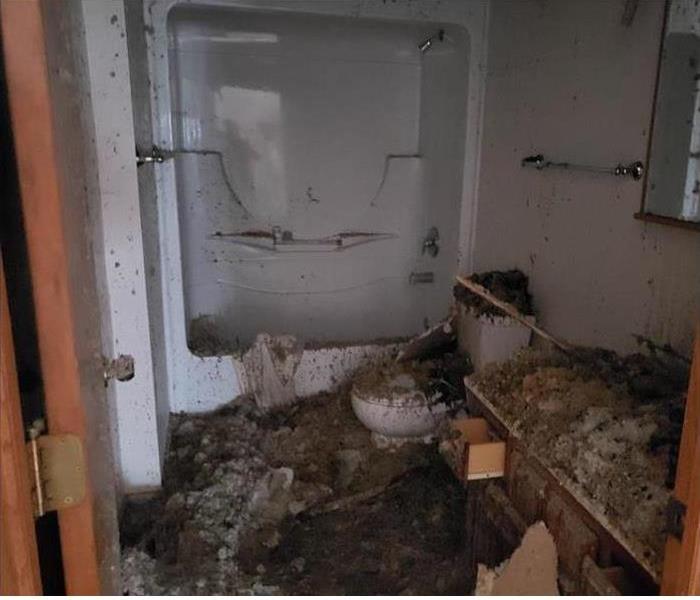 We can react and respond quickly to your commercial damage emergency. Contact SERVPRO, Our team of technicians makes it "Like it never even happened."
We can react and respond quickly to your commercial damage emergency. Contact SERVPRO, Our team of technicians makes it "Like it never even happened."
Even If It's Clean, It's Still Filthy
Many business owners in West Salem, WI, incur heavy losses because they don't clean up their water issues. That doesn't mean they're lazy, it just means that they don't have the knowledge necessary to do a complete recovery. You could also be in danger if you have suffered water damage of any type, including:
- Broken pipes
- Flooding
- Leaks
Black Mold
Black mold is one of the reasons that it's important to have your water damage repair performed thoroughly. This nefarious organic pollutant loves high humidity. In fact, all it needs to start taking over your business's facilities is a little extra moisture. It uses the softened building materials as both food and habitat, creating whole colonies of mold. That's the last thing you want around in a workplace.
Structural Weakening
Mold isn't the only thing that likes wet buildings. In fact, improper drying might lead to infestations of much larger life forms, such as termites or rodents. Termites prefer to eat building materials that have been softened by water, whereas rodents find it much easier to chew through weakened woods. The good news is that, like black mold, it often takes these creatures a little time before they figure out that your structure is vulnerable. If you act quickly enough, you might be able to avoid a secondary damage pest problem entirely.
Not every business owner or facility manager in West Salem, WI, who has water damage develops a secondary mold damage problem. However, it's usually difficult to tell whether or not you're at risk. Even if it seems like you've cleaned up the whole spill, there are still plenty of spaces where you might have lingering moisture and humidity, such as crawlspaces, insides of walls and around fixtures. It's usually better to inspect the area meticulously before calling your cleanup job finished.
How To Handle Waterlogged Items in Your Home
2/3/2022 (Permalink)
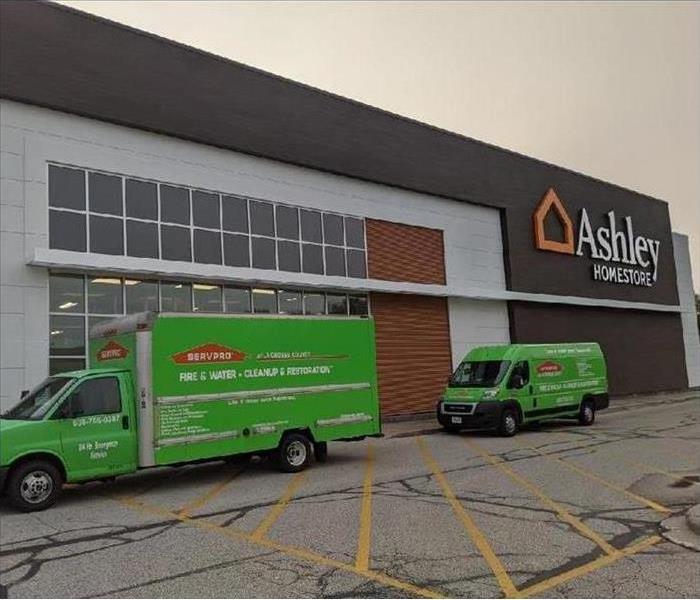 Is water damage present in your home? Call SERVPRO for all your restoration needs. Our crew is always available to take your call.
Is water damage present in your home? Call SERVPRO for all your restoration needs. Our crew is always available to take your call.
What To Do If You Have Waterlogged Items In Your House
If you’ve experienced problems with water in Onalaska, WI from flooding or a broken pipe, you may be wondering how to handle all of your belongings that have been left soaked. By following a few guidelines, you can take the first steps to handling wet items and restoring your home to normal conditions.
Items You Can Save
When looking through possessions that have gotten wet, determine which ones are nonporous. These objects do not soak up water and can therefore be cleaned up easily. Plastic or wooden furniture that is not upholstered should be entirely salvageable. Most types of flooring that are not carpet should also be able to be restored to pre-flood conditions. While you can save these items, it is important that you clean and disinfect them thoroughly to avoid mold growth or other problems that can result from contaminated water.
Items You Should Replace
Fabrics, carpet, upholstered furniture, and other items that water can soak into may have to be more carefully evaluated. Depending on what type of water has invaded your home, you may or may not be able to save these objects. If the water was black or gray water, then it can be best to simply discard and replace porous items. Black water is highly contaminated water that comes from sewage leaks or outside floods. Gray water may be less contaminated than black water but can still contain harmful microorganisms.
If the water was from a clean source, then porous items may be saved through drying and dry-cleaning processes. You can hire a professional damage restoration company to help you sort through affected items and determine the extent of damage and contamination.
Figuring out what to do with waterlogged objects can be the first step to returning life to normal after dealing with water in your home. Sorting through items can help you determine what to keep and what to replace.
4 Steps To Take To Begin a Water Damage Claim
1/3/2022 (Permalink)
4 Steps To Getting A Water Damage Claim Started
Filing an insurance claim after water damage hits your home in West Salem, WI, can be daunting. Stress from the water damage can linger while you try to figure out when to move quickly and when to wait for help; however, no matter what part of your home the flood water damaged, you probably want to begin the claim process as soon as possible after discovering the water. Here are some simple steps to get you started.
1. Contact Water Professionals
No matter what caused the water damage, the first step is typically to contact a water removal professional service. The team can quickly remove the water and help you prevent additional damage to your home that standing water can cause.
2. Telephone Your Agent
When you notify your insurance agent about the pipe burst, the overflowing toilet, or dishwasher eruption, the water damage claim begins. Be prepared to answer questions and send the company any photos you may have taken of the incident.
3. Request an Inspection
During your initial conversation with your agent about the insurance claim, don’t forget to request an inspection by a licensed insurance adjuster. Not only can he or she inspect the water damage, but the inspector can also interview you and collect any additional information you have gathered since the initial interview.
4. Process Claim Forms
Upon receiving the claim form, promptly fill it out and return the pages to your insurance company. If you fear you do not have all of the necessary information, contact your agent to stipulate that the company allows addendums. Request a letter stating the length of time any additional information will be accepted.
Water damage repairs and restoration can be a long process, but if you follow these four steps, you can be well on your way to moving through the insurance claim with a minimum of trouble. During the days, weeks, and sometimes months following the water fiasco, don’t forget to ask questions, keep receipts, and remain in contact with your insurance agent.






 24/7 Emergency Service
24/7 Emergency Service





